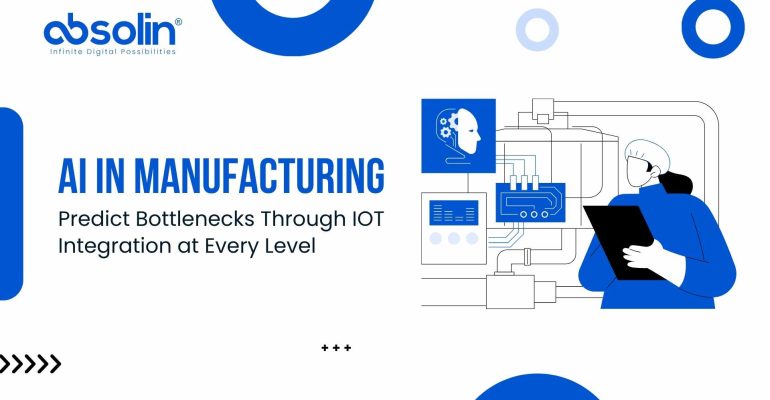AI in Manufacturing: Predict Bottlenecks Through IoT Integration at Every Level

AI in Manufacturing: Predict Bottlenecks Through IoT Integration at Every Level
In a typical factory, machines hum, conveyor belts glide, sensors blink and chaos lurks just beneath the surface. Not the chaos of failure, but the chaos of unknowns. Will that lathe break down in the next shift? Why did production slow by 6% last Tuesday? Why is one assembly line consistently underperforming?
For decades, manufacturers have run blind in these areas relying on maintenance logs, human instinct, and the occasional fire drill when things go wrong.
Now, imagine a different kind of floor: one where machines communicate with each other, share performance data in real time, and send proactive signals when a delay is looming. A place where bottlenecks are predicted before they become problems.
Welcome to the future of manufacturing powered by AI and IoT integration.
In this blog, we’ll explore how the marriage of Artificial Intelligence and the Internet of Things is revolutionizing the way factories predict, detect, and resolve bottlenecks at every level of production.
1. Understanding the Problem: Bottlenecks Are Silent Profit Killers
In manufacturing, a bottleneck is any point in the process where the flow is restricted or delayed, causing inefficiencies, production slowdowns, and increased costs.
Common Bottleneck Sources:
- Outdated or overworked machinery
- Poorly sequenced tasks or unbalanced workflows
- Inventory mismanagement
- Human error or absenteeism
- Maintenance lags and unplanned downtime
The real challenge? Bottlenecks often don’t reveal themselves until after damage is done. Traditional monitoring lacks the depth, speed, and precision to predict them accurately.
2. The IoT + AI Advantage: Visibility and Foresight at Every Level
When IoT meets AI, manufacturers gain a multi-layered intelligence system:
IoT: The Sensory Network
Internet of Things devices collect granular, real-time data from every node—machines, tools, inventory systems, even employee wearables.
AI: The Analytical Brain
Artificial Intelligence processes that data, learns patterns, detects anomalies, and predicts potential disruptions before they escalate.
Together, they enable a shift from reactive to proactive manufacturing.
3. Predicting Bottlenecks: How It Works in Practice
Here’s how AI and IoT integration prevents production disasters:
Step 1: Real-Time Data Collection
Sensors on machines capture metrics like:
- Temperature
- Vibration
- Load and speed
- Output rates
- Idle vs. active time
IoT devices also monitor environmental factors, inventory flow, and operator behavior.
Step 2: Centralized Data Aggregation
Data is transmitted to edge devices or cloud platforms where it’s structured and made accessible.
Step 3: AI-Powered Pattern Recognition
AI algorithms process historical and real-time data to:
- Identify deviations from baseline efficiency
- Highlight repetitive patterns of slowdown
- Detect multi-point correlations (e.g., when humidity + overload = machine slowdown)
Step 4: Predictive Alerts & Workflow Adjustments
When a potential bottleneck is detected:
- Managers are alerted
- Workflow is rerouted
- Preventive maintenance is scheduled
- Inventory or staffing levels are adjusted
4. Use Cases: AI + IoT in Bottleneck Prevention
🔧 Machine Maintenance Optimization
AI predicts when a machine will fail not based on time but based on performance data, reducing unplanned downtime.
Example: A CNC machine shows increased vibration levels. AI compares this to previous failure cases and flags it for preemptive servicing.
🏭 Assembly Line Synchronization
IoT tracks each station’s throughput. AI identifies mismatches and proposes sequencing changes to balance the load.
Example: Line 3 is consistently delayed due to upstream overproduction. AI suggests pacing adjustments or reassigns workload dynamically.
📦 Smart Inventory Management
Sensors and RFID systems track parts movement. AI detects patterns where inventory lags cause production halts, then automates reordering.
Example: A spike in rejected parts leads to part scarcity. AI cross-references the supplier delivery logs and proposes switching to an alternate source.
👨🏭 Human + Machine Coordination
Wearables or smart tags monitor worker fatigue, movement, and proximity. AI allocates breaks and reassigns tasks to avoid human-caused slowdowns.
Example: A fatigued operator at a critical station is flagged by AI, which triggers a shift reassignment.
5. Benefits Beyond Bottleneck Prediction
Leveraging AI and IoT for bottleneck management produces wide-reaching improvements:
| Benefit | Impact |
| Reduced Downtime | Fewer unplanned halts → higher uptime |
| Increased Throughput | Balanced workflows → more output per shift |
| Lower Operational Costs | Better planning = less waste and rework |
| Higher Product Quality | Stable lines reduce errors and defects |
| Real-time Decision Making | Managers act on data, not gut instinct |
6. Challenges to Consider And How to Overcome Them
⚠️ Data Overload
Collecting massive amounts of data is easy. The challenge is making sense of it.
✅ Solution: Use AI models with filtering and prioritization logic. Don’t aim for more data—aim for better signals.
⚠️ Integration Complexity
Older equipment may not support IoT natively.
✅ Solution: Retrofit legacy machines with compatible sensors and edge devices. Use middleware for data bridging.
⚠️ Skill Gaps
Operators may struggle to interpret AI insights or adapt to new workflows.
✅ Solution: Invest in upskilling and create human-in-the-loop systems that empower, not replace workers.
7. Getting Started: A Practical Roadmap
If you’re ready to bring predictive intelligence to your factory floor:
Step 1: Identify Critical Bottleneck Zones
Audit where past disruptions occurred and where real-time visibility is lacking.
Step 2: Start Small with a Pilot Project
Choose one line, one machine, or one workflow to integrate with IoT sensors and AI dashboards.
Step 3: Invest in Scalable Infrastructure
Use cloud platforms or edge gateways that allow for modular expansion.
Step 4: Monitor, Learn, Iterate
AI gets smarter with time. Use feedback loops to continuously improve predictions.
Conclusion: From Factory Noise to Data-Driven Symphony
In manufacturing, silence isn’t golden, it’s dangerous. It’s what happens before the machine breaks, before the supply chain stalls, before output slumps.
But with AI and IoT, you don’t have to wait for silence to act. You can hear the whispers of inefficiency, the murmur of misalignment, and the warning rumble of failure before they become disruptions.
By embedding intelligence at every level of production, manufacturers don’t just eliminate bottlenecks, they unlock the ability to predict, evolve and thrive.
The future of manufacturing isn’t just automated. It’s intelligently aware.
Looking to integrate AI and IoT in your manufacturing workflows? Let’s build a predictive intelligence model tailored for your factory floor.


